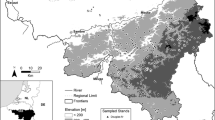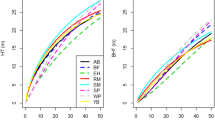Abstract
Predicting timber volume can be important for decision- making. Conventional forest growth models are generally based on mensuration data acquired in fully stocked homogeneous tree stands, and do not consider the wide spacings often adopted in European agroforestry. In order to test the possibility of adapting conventional forestry growth models, diameter and height growth were measured on widely spaced trees. Parameters of a Gompertz double exponential function were adjusted for several tree species planted at wide spacings. Spacing, vegetation control, and individual tree shelters affected the parameters. At wide spacings, the asymptote for diameter growth was larger, and the asymptote for height growth smaller, compared to conventional forestry.
Similar content being viewed by others
References
Auclair D (1996) Scientific and technical basis for silvopastoral systems in Europe. In: Étienne M (ed) Western European silvopastoral systems, pp 195–206. Science update, INRA éditions, Paris, France
Balandier P (1997) A method to evaluate needs and efficiency of formative pruning of fast-growing broad-leaved trees and results of an annual pruning. Can J For Res 27: 809–816
Balandier P and Dupraz C (1998) Growth of widely spaced trees. A case study from young agroforestry plantations in France, Agrofor Syst 43: 151–167
Bergez JÉ and Dupraz C (1997) Transpiration rate of Prunus aviumseedlings inside an unventilated tree-shelter. For Ecol Manage 97: 255–264
Budd WW, Durchhart I, Hardesty LH and Steiner F (ed) (1990) Planning for agroforestry. Elsevier, Amsterdam, the Netherlands, 338 pp
Chambers JM and Hastie TJ (ed) (1992) Statistical models in S. Chapter 10: non-linear models, pp 421–454. Wadsworth & Brooks/Cole, Pacific Grove, CA, USA
Dohrenbusch A and Frochot H (1993) Forest vegetation management in Europe. In: Gjerstad DH (ed) Proceedings, International conference on forest vegetation management, pp 20–29. Auburn University, Alabama, USA
Dupraz C (1998) Adequate design of control treatments in long term agroforestry experiments with multiple objectives. Agrofor Syst 43: 35–48
Gompertz B (1825) On the nature of the function expressive of the law of human mortality and on a new mode of determining the value of life contingencies. Phil Trans Roy Soc 115: 513–585
Huet S, Bouvier A, Gruet MA and Jolivet E (1996) Statistical tools for non-linear regression. Springer Verlag, New York, USA, 155 pp
Knowles RL and West GG (1986) The use of crown length to predict the effects of pruning and thinning in Pinus radiata. In: Fujimori T and Whitehead D (ed) Crown and canopy structure in relation to productivity, pp 104–117. Forestry and forest products research institute, lbaraki, Japan
Krajicek JE, Brinkman KA and Gingrich SF (1961) Crown competition factor: a measure of density. For Sci 7: 35–42
MacDicken KG and Vergara NT (1990) Agroforestry: classification and management. John Wiley and sons, New York, USA, 382 pp
Meredieu C, Arrouays D, Goulard M and Auclair D (1996) Short range soil variability and its effect on red oak growth. Soil Sci 161: 29–38
Nair PKR (1993) An introduction to agroforestry. Kluwer Academic Publishers, Dordrecht, the Netherlands, 499 pp
Pryor SN (1988) The silviculture and yield of wild cherry. Forestry Commission Bulletin 75, HMSO, London, UK, 23 pp
Reffye P de, Houllier F, Blaise F, Barthélémy D, Dauzat J and Auclair D (1995) A model simulating above-and below-ground tree architecture with agroforestry applications. In: Sinclair FL (ed) Agroforestry: science policy and practice, pp 175–197. Kluwer Academic Publishers, Dordrecht, the Netherlands
Reineke LH (1933) Perfecting a stand-density index for even-aged forests. J Agric Res 46: 627–638
Ritchie MW and Hann DW (1985) Equations for predicting basal area increment in Douglas-fir and Grand Fir. Forest Research Laboratory, Oregon State University, Corvallis, USA. Res Bull 51, 9 pp
Sibbald AR (1990) The silvopastoral national network experiment. Agroforestry in the UK 1(1): 5–10
Sibbald AR and Sinclair FL (1990) A review of agroforestry research in progress in the UK. Agroforestry Abstracts 3(4): 149–164
Suères C (1997) Modélisation de la croissance du Chêne rough d’Amérique à l’état isolé. Mem DUT, Univ P Sabatier, INRA, Toulouse, France, 25 pp
Tomé M (1998) Empirical and process-based models for forest tree and stand growth simulation. Proceedings, IUFRO 4.01.00 workshop, Lisbon, 21–27/09/1997, in preparation
West GG, Knowles RL and Koehler AR (1982) Model to predict the effects of pruning and early thinning on the growth of radiata pine. FRI Bulletin 5, Forest Research Institute, Rotorua, New Zealand, 35 pp
Author information
Authors and Affiliations
Corresponding author
Rights and permissions
About this article
Cite this article
Cabanettes, A., Auclair, D. & Imam, W. Diameter and height growth curves for widely-spaced trees in European agroforestry. Agroforestry Systems 43, 169–181 (1998). https://doi.org/10.1023/A:1026440329824
Issue Date:
DOI: https://doi.org/10.1023/A:1026440329824




